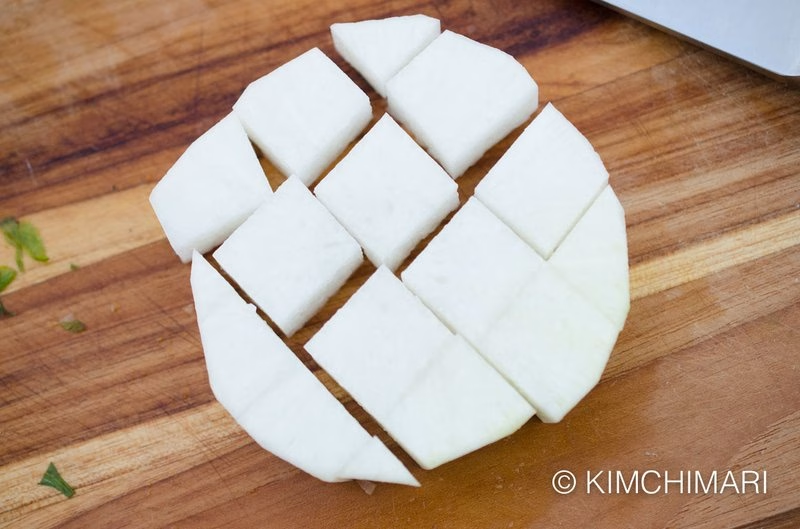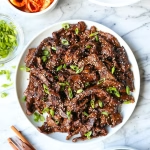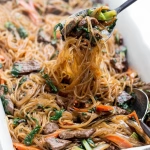
If you’ve ever dined at a Korean restaurant, you might have come across Kkakdugi, a vibrant and crunchy cubed radish kimchi that’s hard to resist. This traditional side dish has a charming appeal, thanks to its unique blend of spicy, sweet, and sour flavors. Originating from Korea, Kkakdugi isn’t just a condiment; it’s a staple that brings life to any meal, particularly enjoyed with kimchi jjigae or Korean stews.
In this article, you will discover the art of making Kkakdugi (Cubed Radish Kimchi) at home, including the essential Kkakdugi (Cubed Radish Kimchi) ingredients, insightful tips, and nutritional insights. Let’s dive into the world of this delightful kimchi and explore the flavors and culture behind it!
Ingredients
| Ingredient | Measurement | Description |
|---|---|---|
| Radish | 2 cups, diced | Fresh radish provides a crunchy texture and subtly spicy flavor, making it the star of Kkakdugi. |
| Salt | 1 cup | Salt draws out moisture from the radish, an essential step for proper fermentation. |
| Korean red pepper flakes (Gochugaru) | 3 tablespoons | Gochugaru gives Kkakdugi its signature heat and rich red hue, elevating the dish immensely. |
| Garlic | 4 cloves, minced | Fresh garlic enhances the aroma and depth of flavor in Kkakdugi (Cubed Radish Kimchi). |
| Fish sauce | 2 tablespoons | This adds a savory umami kick, rounding out the flavors in your Kkakdugi. |
| Green onions | 2, chopped | Green onions add a fresh, mild onion flavor that complements the radish beautifully. |
| Sugar | 1 tablespoon | A pinch of sugar balances the spiciness, creating a well-rounded taste in Kkakdugi (Cubed Radish Kimchi). |
Step-by-Step Instructions
- Step 1: Prepare the Radish – Start by washing and peeling the radish. Cut it into small cubes, roughly ½ inch in size. This shape allows the brine to soak in well, making your Kkakdugi extra flavorful.
- Step 2: Salt the Radish – In a large bowl, mix the cubed radish with 1 cup of salt. Let it sit for about 30 minutes. During this time, the radish will release moisture, allowing it to become crisp and retain its crunch.
- Step 3: Rinse and Drain – After 30 minutes, rinse the radish cubes under cold water to remove excess salt. Drain them thoroughly to ensure no water remains.
- Step 4: Make the Spice Mixture – In a separate bowl, combine minced garlic, fish sauce, Korean red pepper flakes, sugar, and chopped green onions. Mix well until it forms a thick paste.
- Step 5: Toss Together – Add the drained radish to the spice mixture. Use your hands to gently mix everything, ensuring each cube is evenly coated. It’s a bit messy, but that’s part of the fun!
- Step 6: Pack into a Jar – Transfer the seasoned radish into a clean jar, pressing down to eliminate air bubbles. Leave some space at the top to allow for fermentation.
- Step 7: Ferment – Seal the jar and leave it at room temperature for 1-2 days to ferment. After initial fermentation, store it in the refrigerator. It’s ready to enjoy, but waiting a week will enhance the flavors!
Pro Tips
- Be mindful of the salt: While salting helps draw moisture from the radish, too much salt can overpower the flavor. Adjust according to your preference.
- Customize your spice level: Feel free to adjust the amount of gochugaru depending on how spicy you like it!
- Experiment with add-ins: Consider adding grated carrots or slices of cucumber for an extra crunch and flavor variation.
- Keep it clean: Always use clean utensils when handling Kkakdugi to maintain its freshness and prevent spoilage.
- Taste before serving: Before digging in, give Kkakdugi a taste after a few days in the fridge. You can always let it ferment longer if you like a stronger flavor!
Nutritional Information
| Nutrient | Per Serving (100g) |
|---|---|
| Calories | 40 |
| Protein | 1g |
| Carbohydrates | 9g |
| Saturated Fats | 0g |
| Fiber | 2g |
| Cholesterol | 0mg |
| Sugars | 1g |
| Fat | 1g |
FAQs
What is the best way to store Kkakdugi (Cubed Radish Kimchi)?
Store your Kkakdugi in a sealed container in the refrigerator. It can last for several weeks, with flavors intensifying over time!
Can Kkakdugi (Cubed Radish Kimchi) be made vegan or gluten-free?
Yes! To make it vegan, simply substitute fish sauce with soy sauce or a vegan alternative.
What are the best side dishes to serve with Kkakdugi (Cubed Radish Kimchi)?
Kkakdugi pairs wonderfully with rice, grilled meats, or as a topping for Korean pancakes.
How long does it take to prepare Kkakdugi (Cubed Radish Kimchi)?
The preparation takes about 15 minutes, plus brining for 30 minutes and fermentation for 1-2 days.
Can I freeze Kkakdugi (Cubed Radish Kimchi) for later?
It’s not recommended to freeze Kkakdugi, as it may affect the texture. Enjoy it fresh for the best crunch!
How spicy is Kkakdugi (Cubed Radish Kimchi)?
The spice level can be adjusted based on how much gochugaru you add. Generally, it’s moderately spicy.
What types of radish should I use for Kkakdugi?
Typically, Korean radish (mu) is used, but you can also use daikon radish for a similar texture and taste.
Can Kkakdugi (Cubed Radish Kimchi) be made without fish sauce?
Absolutely! You can omit it or use a substitute like soy sauce for a delicious vegetarian option.
In a culinary world filled with flavors, Kkakdugi (Cubed Radish Kimchi) stands out with its crunchy texture and zesty taste. It embodies not only the spirit of Korean cuisine but also the joy of homemade cooking. Whether enjoyed alone or as a side dish, Kkakdugi is sure to delight. So why not try making Kkakdugi (Cubed Radish Kimchi) at home? It’s easier than you might think! Share your experiences in the comments below, and happy cooking!





